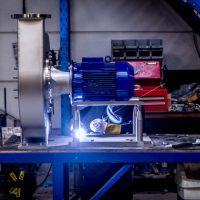How even your factory can get stuck
On this page, you will find a simple example of how work in process in a factory can accumulate, and a specific part of the factory can get stuck without being able to predict the blockage. You can also see why chaos easily arises and continuous review is needed about the planning.
As you may understand, it is an illustration to show a principle that occurs daily in production, making it difficult for manufacturers to meet their delivery times. PROPOS with Digital POLCA prevents these situations from occurring, as happens in the below example.
An example
We are looking at a factory with the same composition as the figure on the previous page with the departments / work cells A to G. Orders always start at A and end at G. In this example, we are going to send 6 production orders through the factory. The first time, no details take place, and orders run smoothly through the factory (utopian situation). The second time we will see how a small-unforeseen circumstance has significant negative consequences for the functioning of the factory. Let’s take a look at 10 production steps that could correspond to 10 production days. Orders are indicated with an order number (1 to 6), and their route through the factory is described by the successive work cells with commas between them. The different orders have – just like in practice – different delivery dates, different routes and therefore also different planned start dates.
Other starting points for this example are:
– Orders take 1 production step (1 day) per work cell
– Each work cell can handle a maximum of 2 orders per step
– While these 6 orders are running through the factory, new orders are always being added. We do not show this in the simulation.
The 6 production orders are:
Order 1, delivery day: 9, Route: A, C, B, E, D, E, F, G
Order 2, delivery day: 11, Route: A, B, C, B, F, E, G
Order 3, delivery day: 7, Route: A, B, E, G
Order 4, delivery day: 10, Route: A, B, D, F, D, C, G
Order 5, delivery day: 10, Route: A, B, C, F, G
Order 6, delivery day: 9, Route: A, B, C, F, D, E, G
These orders are planned so that a start date is known. On the delivery day, the order must reach the customer, which means that the order must be in the last cell G 1 day before. This yields the following list of start dates:
Order 1, starting day: 1 (because on day 8 in G)
Order 2, starting day: 4
Order 3, starting day: 3
Order 4, starting day: 3
Order 5, starting day: 5
Order 6, starting day: 2
Simulation 1: everything goes as planned
In the following simulation, everything will be fine, meaning that all orders go through the factory step-by-step without planned (not slower but also not faster). This situation does not occur in any factory. We will not describe every situation step by step. You can see from the routes and the start list how orders go through the factory for yourself.
Steps 1 and 2
Step 1: order 1 starts at A according to the start list (schedule)
Step 2: order 1 goes to C according to route plan, order 6 starts at A

Steps 3 and 4

Steps 5 and 6

Steps 7 and 8

Steps 9 and 10

After step 10, order 2 runs out of G, and all production orders are processed without problems and according to planning.
Simulation 2: something unexpected happens and then ... chaos ...
In the following simulation, just one unexpected situation occurs. This is because during step 2 the working cell C is not available or is available to a limited extent. This could be due to a machine malfunction or a sick employee. This unforeseen situation will lead to certain choices having to be made and eventually cell F to crash completely. Remember that in reality new orders are coming into the factory outside of these 6 orders and see how one unexpected situation will already cause chaos in the factory with work in progress everywhere, putting down fires and long and unreliable delivery times.
Steps 1 and 2
Step 1: order 1 starts at A according to the start list (schedule)
Step 2: order 1 goes to C according to route plan, order 6 starts at A

However, in step 2 an unexpected situation occurs at work cell C. As a result, order 1 cannot be processed there at this time. Order 1 will be processed on this cell in step 3.
Steps 3 and 4

In step 3, orders 3 and 4 arrived at work cell A. Order 1 is handled by work cell C.
In step 4 it all goes wrong. Order 1, 3 and 4 arrive simultaneously in B, while B can only process 2 orders. There is consultation in the factory, and it is decided to let order 4 wait. Order 1 had already been delayed, so we will not hinder that further. Order 3 has a short delivery time, so it has to continue.
Steps 5 and 6

Step 5 goes smoothly. In step 6, however, the following problem occurs. There are 3 orders in D while D can only process two orders. The people in the factory must come together to discuss how to solve this. The delivery time of order 1 is fast approaching. Order 4 still has to go through a lot of steps and that delivery time is the furthest away. Order 6 must be in cell G in 2 steps to meet the delivery time. Therefore it is decided to process orders 1 and 6 and to keep order 4 waiting.
Steps 7 and 8

In step 7 everything seems to be under control again. But then suddenly in step 8, 4 orders arrive at the same time in work cell F. Panic! Order 1 has to be continued because it has to be delivered after this step but it still has to pass G. Inevitably it will arrive too late for the customer. Order 5 is still on schedule but must then go to G to arrive at the customer on time. Order 2 must be delivered on day 10, but it must still be sent to E as well. Therefore, this order will also be late. Order 4 actually has to go to G, as well to be finally delivered after all, because it is already too late! It still has to go to D, C and only then to G while the agreed delivery day was 9! That will never happen again. The chaos is complete!
Steps 9 and 10

Order 1 is at the customer on step 10. Too late.
Order 5 is at the customer on step 10.
Order 2 will be with the customer on step 12. Too late.
Order 4 will be with the customer on step 13. Too late.
Conclusion
Due to unexpected situations that will inevitably occur in your factory, you lose the overview. You are constantly discussing and putting out fires and inevitably exceed set delivery times.
Don’t worry! PROPOS with Digital POLCA will help you solve these problems.

